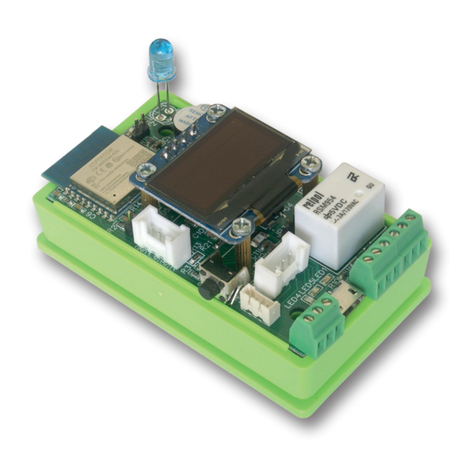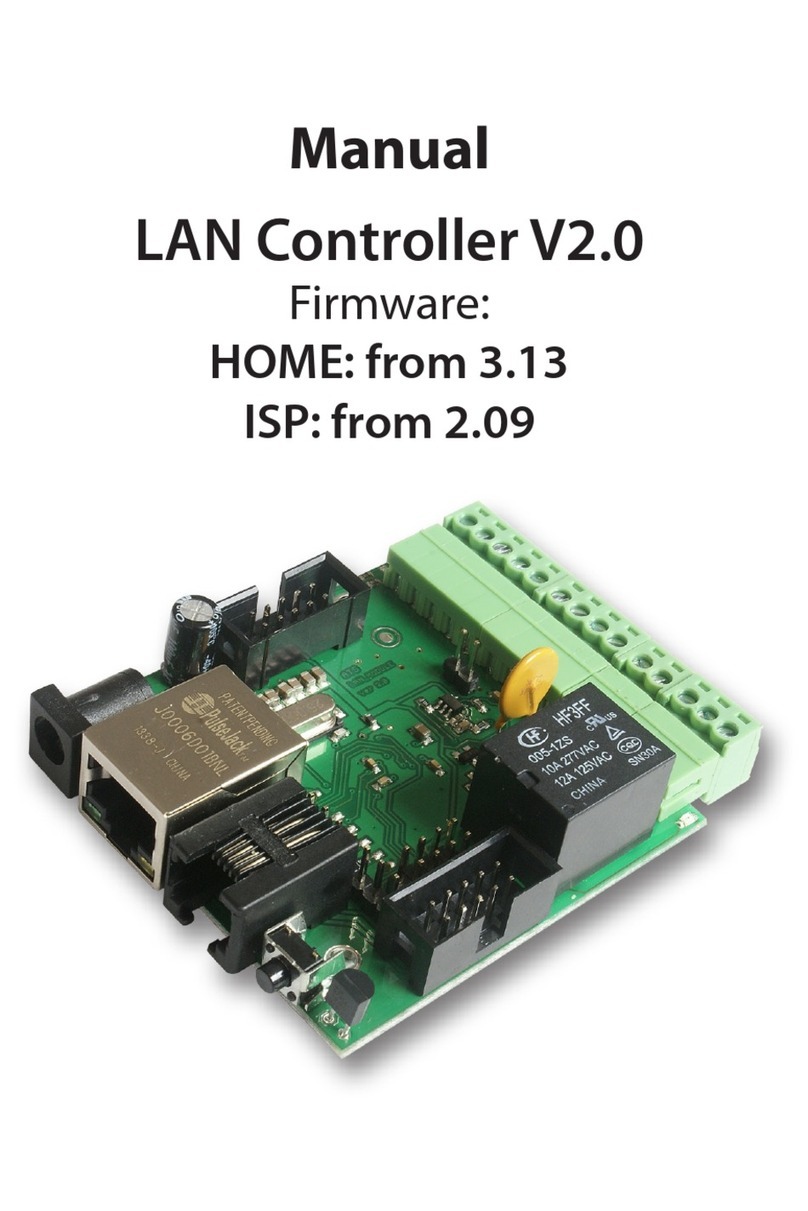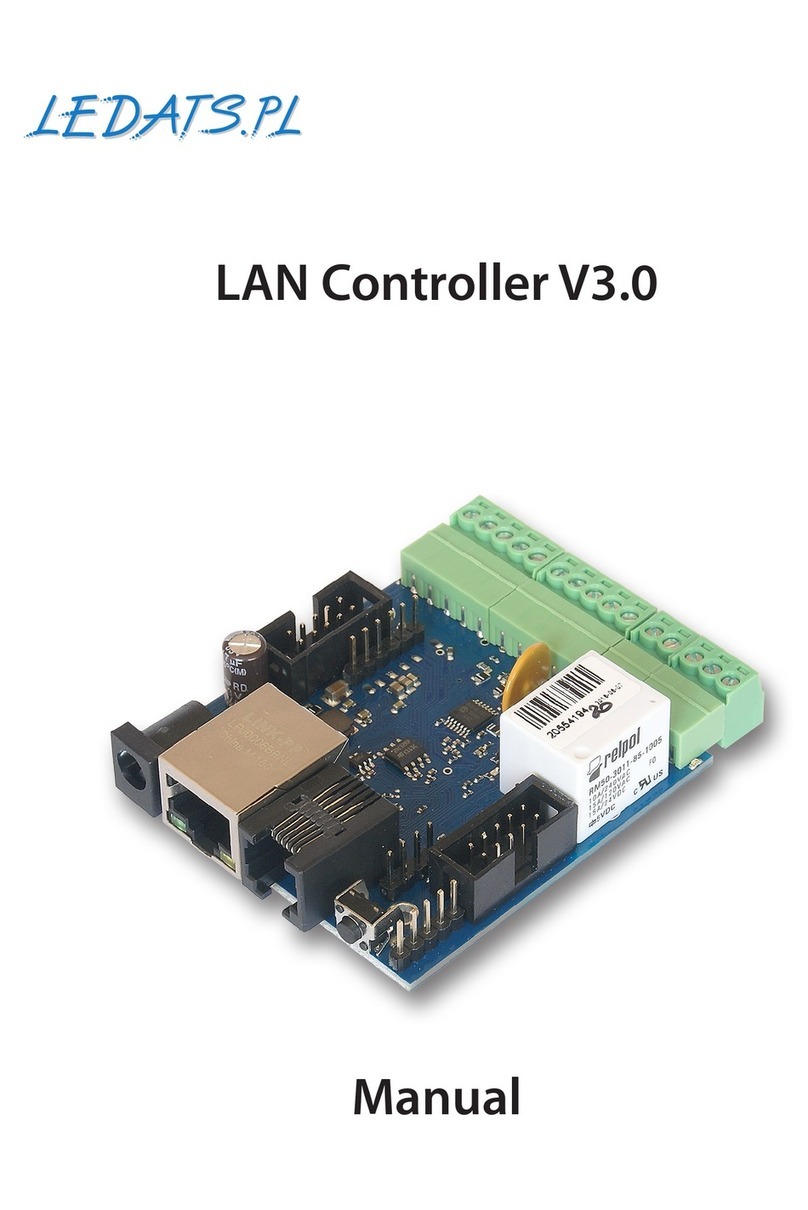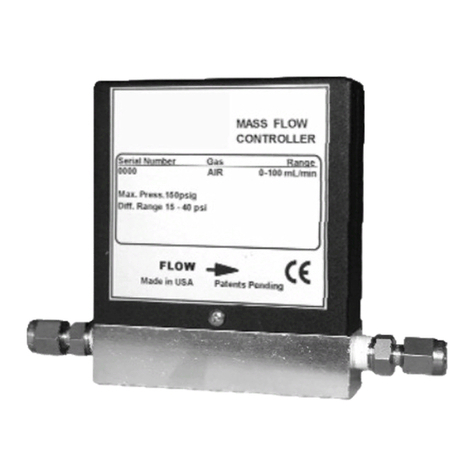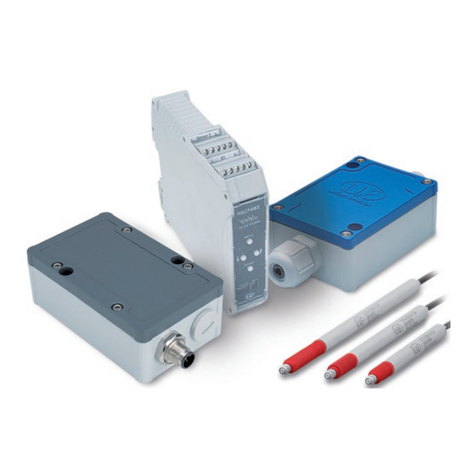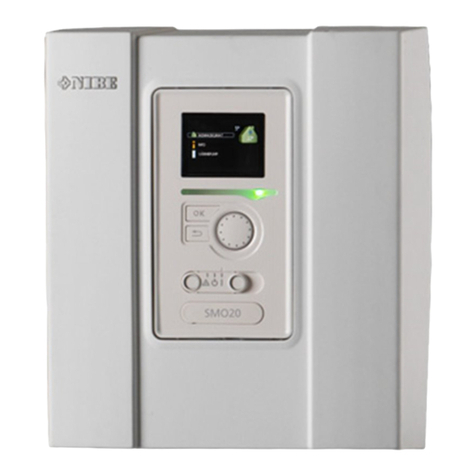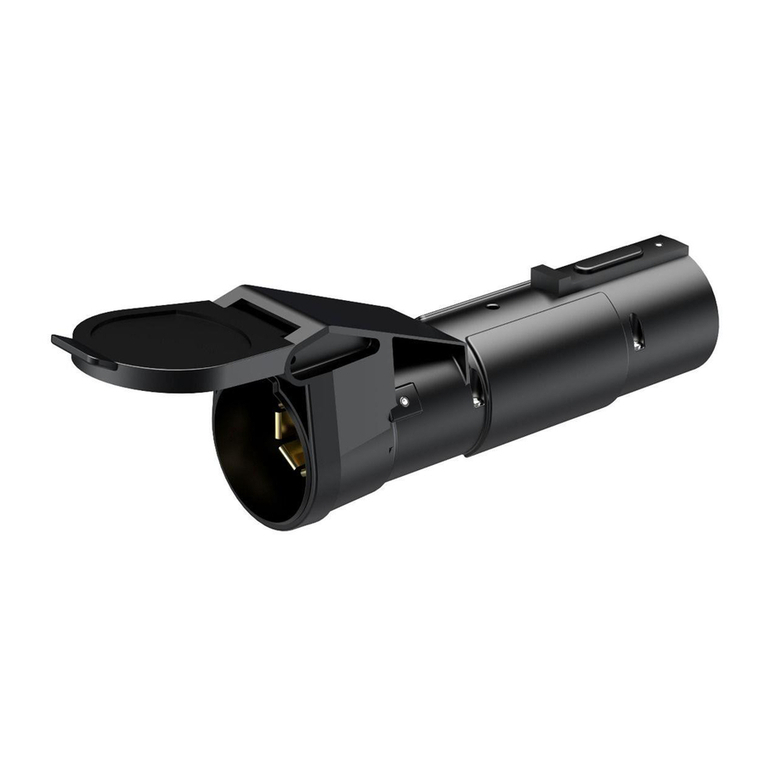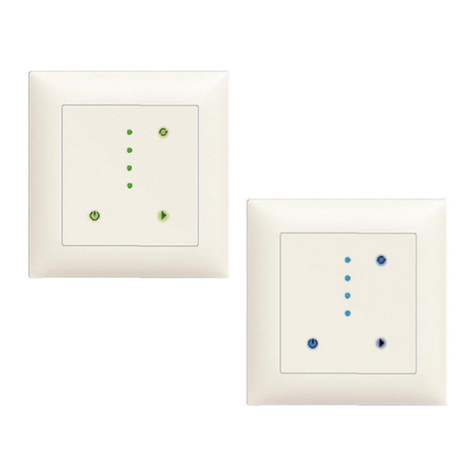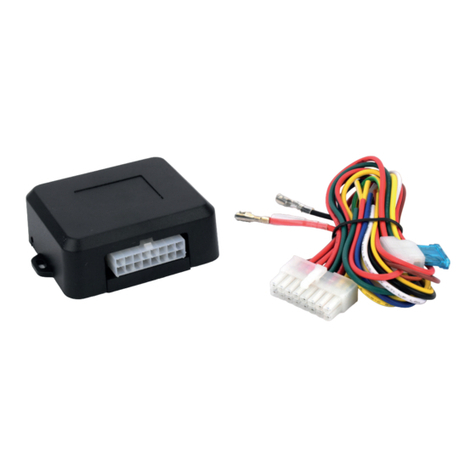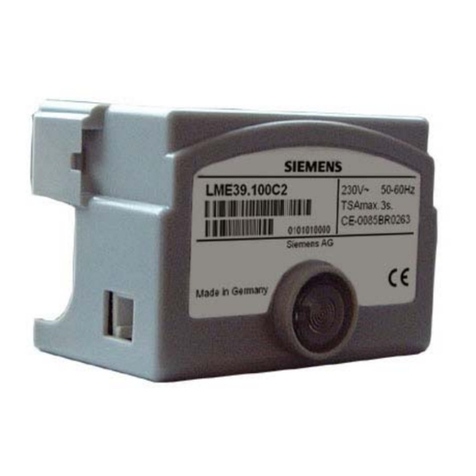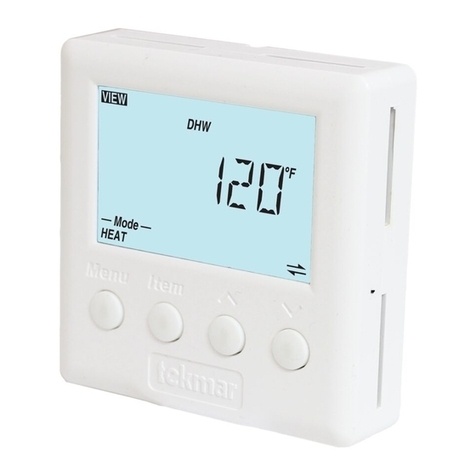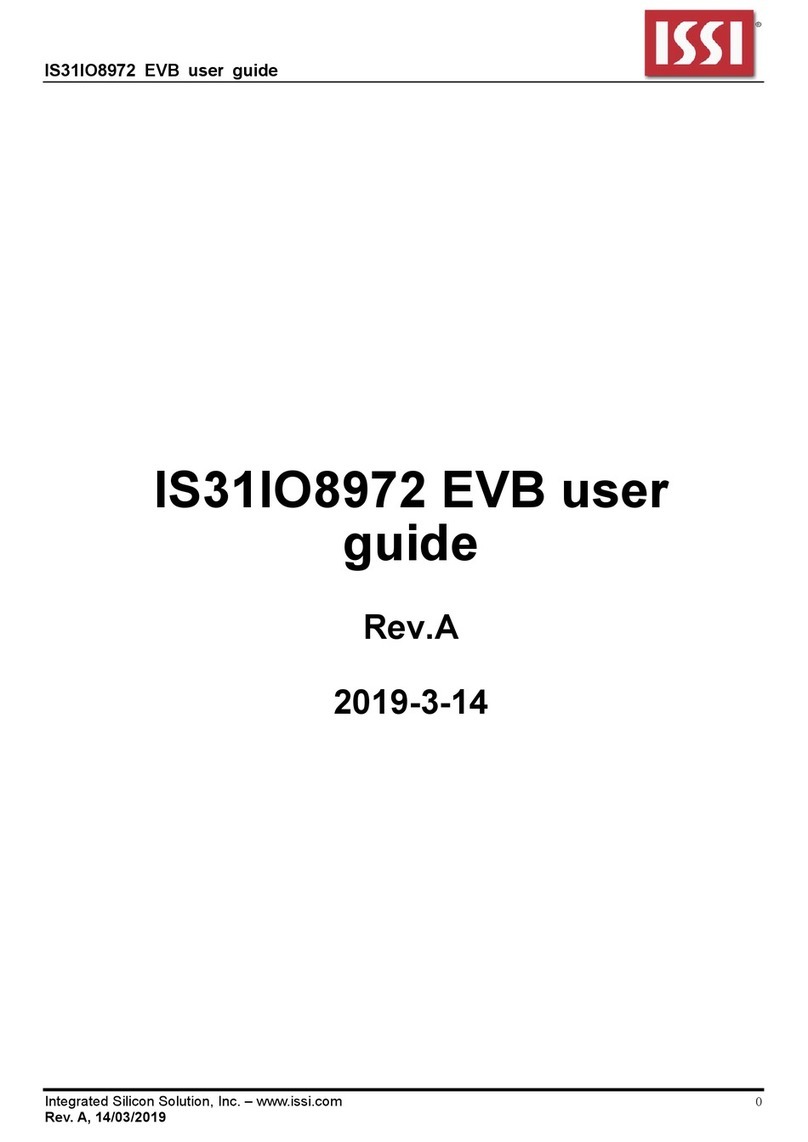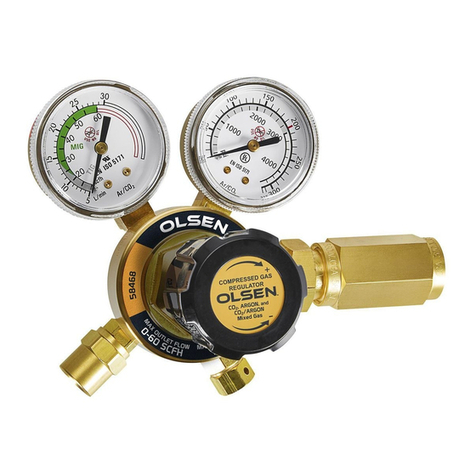Tinycontrol LANKONT-001 User manual

Firmware version 3.21 –„HOME”
LAN Controller
manual

2
manual v. 3.21 HOME – LAN Controller – LANKONT-001
LAN Controller
LAN controller is a simple, but innovative device which has long been lacking in the mar-
ket network solutions. A small board serves as a web server which presents the various
sensor readings and allows you to remotely control up to 5 outputs. Additionally Events
Cong feature allow you to program the appropriate action when sensor readings met
certain conditions. ISP can use watchdog function, it check the ping up to 5 network de-
vices, and if no response runs the relays. Useful for many applications can be a Scheduler,
that allows the on / othe device at a specied time or for a specied period of time.
There is also PWM output to control brightness of light or an electric motor speed. For far
rom socket installation board could be powered by passive PoE. Few versions of rmware
is available today, each is developed and after publication customer could upgrade it by
preapred software. In Accessory are presented all sensors and upgrade kits compatible
with Lan Controller.
Examples of applications
ISP
ttemperature, supply voltage and person occupancy control in server rooms
tweather condition report on the occasion of IP cameras views
Home control
thome electric stove control (automatically or remote)
tturning on/ohome lightening remote, by scheduler or by event, controlling intensity
tturning oTV box if remote is other person hands ;-)
tirrigation control - you don’t need visit your garage to modify irrigation time or you can
turn sprayer precisely in the moment when your favorite neighbor passes near ;-)
Home installations
ttemperature controlling and simple automation in your heating system
ttemperature and pressure controlling in solar thermal installations
tmeasurements of heat pump operation
tmonitoring of grid voltage and automatic switching to backup with mail notication
tremote control (by LAN or wirelesslan) understands as forwarding command to one of
output of Lan controller from input of other Lan controller
Renewable energy
tmeasurements of solar cells work
tmeasurements of wind turbines
tmeasurements of charging battery
tmeasurements of power consuming

manual v. 3.21 HOME – LAN Controller – LANKONT-001
3
RESTARTER, MONITOR, CONTROLLER
FEATURES:
tWWW or SNMP v2 management
trmware upgrade via TFTP
tread data in real time without refreshing page
tpossibility switch on/oto 5 relay direct from page WWW
tevents panel to self-programming by user
tScheduler (switch on/ooutput for denite time in week days)
tmonitoring additional devices eg. PIR sensors
tenvironmental temperature and supply voltage on board measurement
ttemperature and current measurement from connected sensors
tpower measurement for DC voltage
tpossibility to connecting of the additional boards: with 4 switched PoE ports or 4 relays
tset time manualy or by server NTP
tposisibility sensors calibration
tfrequency and duty modied PWM output
tremote control: each output of Lan controller setup as server can be controlled remo-
telly by LAN network from inputs of others Lan controllers
te-mail notication about programmed events
tSNMP TRAP notication about programmed events
tHTTP client: GET, POST notication
tautomaticaly send state or value inputs to SNMP server
timplemented protocols: HTTP, SNMP, SMTP, SNTP, ICMP, DNS, DHCP
tsupported temperature sensors: NTC10K B=3950, KTY-84, PT1000
tpower measurement from pulse meters DTH22 humidity sensor support
tsupport for monostable/bistable wall switches for lighting control
thttp client for send data to remote IoT servers like www.thingspeak.com
tno watchdog
Default user and password is„admin”, IP adress is 192.168.1.100

4
manual v. 3.21 HOME – LAN Controller – LANKONT-001
TECHNICAL SPECIFICATIONS
tsupply voltage: 8÷56V
tpower consumption : about 1W
tPoE supply: YES, passive
tProtection from wrong supply polarization: YES
tinterface: ethernet 10Mbit/s
trelay: 255VAC 10A
toperating temperature: –20 do +85 °C
tweight 45g (without casing)
tcasing type Z-67 (not included)
tdimensions 57x67mm
INPUT/OUTPUT:
t1 RELAY to switch on/oanother devices, available contact: NC and NO
t4 OUTPUT to switch relays, ports PoE or another devices;
t1 CONFIGURABLE PWM OUTPUT from 2,6 KHz to 4Mhz;
t4 LOGICAL INPUT (max 12V): to monitoring another devices, eg. bufor supply. colla-
boration with outputs: OC,NO, NC
t5 ANALOG INPUT:
INP1: temperature measurement witch thermistor NTC 10K B=3950 (from –40 to +120 °C)
or thermistor KTY-84-130 (from –40 to +300°C), accuracy 1°C (dependent on NTC)
INP2: thermistor NTC 10K or voltage mesurement to 3,6V, with use additional divider
increase range.
INP3: voltage measurement to 35V, accuracy ± 0,1V;
INP4: temperature measurement by PT1000 (from –20 to +350 °C) accuracy ± 2°C;
INP5: measurment DC current to 3A, accuracy ± 10mA;
t1-WIRE BUS (RJ11 connector) to input sensor DS18B20 - max 6 sensors

manual v. 3.21 HOME – LAN Controller – LANKONT-001
5
PINS and COMPONENTS DESCRIPTION
Temperature board sensor. Ethernet
10Mbit.
PIN/Component Description
Power Power suplly 8V÷56VDC or via PoE
RELAY bond To connect external device, detail description below
LED1 Shine LED means Power on board
LED2 Shine LED means relay active
IDC10 To connect additional board, detail description below
INP1D Logical input 1
GND1 gnd for INP1D and INP2D or general gnd
INP2D Logical input 2
GND2 general gnd
+3,6V Supply for sensors NTC-10K and KTY-84 connected to INP1 or INP2
INP1 input for sensor NTC-10K or voltage measurement max (without divider ) 3,6V
INP2 input for sensor NTC-10K or KTY-84-130
INP3 input for voltgae measuerment max 35V
GND3 general gnd
INP4 input for sensor PT1000 or connected the same sensor in solar controller
INP5 Input for current measurement
GND4 Gnd for current measurement Or general if don’t measurement current
INP6 input for sensor DS18B20 (1-Wire bus on the connector RJ11)
INP3D Logical input 3
INP4D Logical input 4
GND5 gnd for INP3D and INP4D or general gnd
RESET button,
change relay
state and do
sets reset
Relay bond
(output OUT0)
IDC10
INP1D
GND1
INP2D
GND2
+3,6V
INP1
INP2
INP3
GND3
INP4
INP5
GND4
Power
LED 1
LED 2
INP6 - RJ11
1-Wire bus
for DS18B20
GND5 INP4D INP3D

6
manual v. 3.21 HOME – LAN Controller – LANKONT-001
Relay Bond:
NO – contact normaly open
CON – common contact
NZ – contact normaly closed
ATTENTION: In spite of that relay can switch AC voltage 255VAC 10A, board fail to com-
ply with safety requirements (lack housing, earthing). Therefore that receiver connect
with the assistance safety external relays eg. on DIN bus, controlled by relay on board.
IDC10 and 1-Wire:
1 – analog input not use 2 – analog input not use
3 – +3,6V 4 – OUT4
5 – GND 6 – OUT3
7 – PWM output 8 – OUT2
9 – VIN, vcc suplly 10 – OUT1
Reset button
Push about 0,5 second cause change relay state on opposite, push and keep longer about
5 second (if we not logged by WWW on modul) cause modul reset, next if you still keep
button about 10 second cause set all settings to default. Set all settings to default conr-
mation is fast switch relay on/o(klik-klik), don’t wrong this with change relay state about
0,5s and switch relay oafter restart.
User and password: admin
IP: 192.168.1.100
1 2
9 10
GND 1-Wire not
use VCC=3.6V
RESET
ETHERNET
10 Mbit
NO CON NZ

manual v. 3.21 HOME – LAN Controller – LANKONT-001
7
SENSORS CONNECT
1. Current measurement
2. Temperature measurement and logical input
GND4
–
+
Power
receiver
max 3A
VCC
–
+
Power
supply
INP4
GND3
INP2D
GND1
INP1D
PT-1000
INP2
INP1
+3.6V
NTC-10K
or KTY84
NTC-10K

8
manual v. 3.21 HOME – LAN Controller – LANKONT-001
3. Voltage measurement
Additional resistor to increase measure range INP1
R = 10K increase range 2 (multiplier 2) that is 3.6V x 2 = 7.2V
R= 20 K increase range 3 (multiplier 3)
R= 30 K increase range 4 (multiplier 4) etc.
Add resistor must be connected with set proper multiplier in eld VCC on control panel
page.
INP3
GND3
INP1
GND2
INP1 is use to temperature
measure or voltage,
in control panel you must
choice what you want
measure
INP1
Measure voltage
max 3.6 V DC
or more if you
add divider
resistor
Measure voltage
max 35 V DC
Measure
voltage
R
multiplier

manual v. 3.21 HOME – LAN Controller – LANKONT-001
9
4. DHT22 sensor and pulse output from the counter
Despite of connected sensors, inputs INP4D and INP3D can still be used as a standard di-
gital inputs in an array of events, just for the DHT11 at INP4D closed to ground will not be
correct read and the shorting INP4D will calculate extra impulses.
–
+
output terminals
of the meter pulse energy
for dierent counters
may dier markings
20 21
VCC=3.6V
GND5
INP4D INP3D

10
manual v. 3.21 HOME – LAN Controller – LANKONT-001
Management by WWW.
1. Control Panel
Any descrip-
tion of the
measured
physical
quantity,
such as kWh,
L/min, etc.
Negation for
digital input
for Even Con-
g tripping
Divider pulse counter
- for example as ours
energy meter sends
1000 pulses per
1 kWh is enter 1000,
as it sends 1600 pulses
enter 1600, etc.
Choice
of voltage
input for power
calculation
Multiplier of PWM
duty used for INP1
Even Cong table
tripping.
Test input - in the current
rmware version 3.21 - unused
Change outputs
state display
Any text
description,
max 8 chars
Reset time – „0” for normal
outputs work (ON/OFF) ,
for time > 0 output change
state and return to state be-
fore after the specied time
in seconds (max 65534).
Value of calibration
- adds to or subtracts
the desired value
Choice type
connected
sensor
click cause
change relay
state on opposite
(OUT0 relay on
board)
automatic socket
arming at xed
time (two panes:
one - time arming,
second - break
time)
Set State
All output
simultaneously
according to
combo box
Run PWM genera-
tor (when chan-
ging frequency or
ll does not need
to turn othe
generator)
Run Power
measure from
INP3 (voltage)
and INP5 (current)

manual v. 3.21 HOME – LAN Controller – LANKONT-001
11
Delay of set outputs
after occur events,
in seconds max 65535
2. Events Cong
If checked it responds
to a change of state,
otherwise no reaction (o)
Email text taht
will be send if
events occurance,
max amount char
is 79. Chars „=”
and „&” are not
allowed
The hysteresis
value for
a given input.
Save setings
(ON/OFF
input
you don’t
must save)
inclusion
of an input
The value of the
input beyond
the upwards the
the socket will be
activated, send an
e-mail or SNMP
Trap
The value of the
input, after
crossing down that
slot will be
activated, send an
e-mail or SNMP
Trap
For logical input INP1D and INP2D, e-mail and SNMP Trap notication are send when
input level change from 1 to 0 or 0 to 1, additional to email text (at end) will be add
value 1 or 0 mark actual input state.

12
manual v. 3.21 HOME – LAN Controller – LANKONT-001
Auto-adjusting PWM voltage input works for INP1, its eect is to increase the PWM duty
cycle at a specic step (multiplier lling), when the input signal exceeds a predetermined
value INP1.
Example:
Set start lling at 10%, the frequency eg 5000 Hz, 100V switching threshold (to measure
this voltage to INP1 need a divider, described in the general instructions). Now, when the
output voltage exceeds 100V PWM starts with a preset frequency and damping, as long
as the voltage is greater than 100V, the lling will be incremented 5 times per second by
the value of the multiplier (multiplier 1 increases the lling of 0.1%), as the voltage drops
below 100V PWM is turned oand the lling will fall at the same pace as growing.
Bistable operation input
- the rst change at INPD
to turn on output, the
second amendment to
disable output
If a value greater than 0,
is at work bistable output
is automatically switched
oafter this time,
max 255 seconds

manual v. 3.21 HOME – LAN Controller – LANKONT-001
13
Functional Description Event Table
With this change, you can exibly dene thresholds and intervals in which such slot is to
be enabled / disabled.
If you have the proper checks the condition of a number of sensors is to force the state
OUTX outputs and setting the PWM generator to be that was last registered event.

14
manual v. 3.21 HOME – LAN Controller – LANKONT-001
3. Scheduler
Format: number output (from 0 to 4),day1,day2,day3,day4,day5,day6, xx:xx:xx(time)
Week Day: Mo - Monday, Tu- Tuesday, We - Wednesday, Th - Thursday, Fi - Friday, Sa - Sa-
turday, Su - Sunday, ## - all week day. Letter size is important.
Example:
0,Mo,12:23:00 - sets out0 every Monday at 12:23:00
1,Sa;Fi,Mo,23:22:03 - sets out1 every Saturday, Friday and Monday at 23:22:03
1,Sa;Fi,Mo,Tu,Su,Th,23:22:03 - sets out1 every Saturday, Friday, Monday, Tuesday, Sunday
and Thursday at 23:22:03
0,##,12:01:30 - sets out0 every week day at 12:01:30
The eect of this may be the inclusion of a relay, switched oor reset (turn on and o) for
a limited period in seconds. (max 65535).

manual v. 3.21 HOME – LAN Controller – LANKONT-001
15
4. Network Conguration
e-mail client set-
tings parameter.
After changing the
settings in order to
test the customer -
should be save your
settings - the „Save
Cong” button.
Remote Control - working as a server (receiving packets and enables / disables the corre-
sponding output) or client (send packets to the server status change to INP1D or INP2D).
LK working as a server can be actuated from any number of clients, provided it is set to the
same password. Change in INP1D or INP2D low can switch outputs selected in the state of
„ON”, return to enter the high state output switches to „OFF”.

16
manual v. 3.21 HOME – LAN Controller – LANKONT-001
The user name
and password
to access the
module.
You can disable
authorization.
NTP server set-
tings.
Time Interval -
the interval in
minutes betwe-
en synchroniza-
tions.
Fields communi-
ty (password) for
SNMP, must be
the same in your
queries in order
to LK replied.
TRAP Enable –
enabled send
TRAP by SNMP.
HTTP Client Conguration - Below is a sample screenshot settings HTTP client to send
data to the server https://www.thingspeak.com, (you can create an account and test ) .
To add a content query the value of a specic sensor or I/O , use the „# „ and enter the
number (below the list of numbers for I/O ). Said sample server requires a eld name =
value, you can type on a matter such as eld = 12.4, then you will be sent a constant value
12.4 to the server. To send a specic value , enter the sensor eld = # xx, where xx - a two-
-digit number of I/Os. (NOTE! Record must be double digit, as we enter „5” to write „05”.
How do we want to send data from several sensors that use the #xx several times).
Maximum server name is 31 characters, the maximum string RemouteURL is 127 charac-
ters. The time window, type frequency in seconds with which data will be sent to the
server. In the following example, and for normal queries between „GET” and „/” is a space.

manual v. 3.21 HOME – LAN Controller – LANKONT-001
17
#dene OUT0 (5)
#dene OUT1 (6)
#dene OUT2 (7)
#dene OUT3 (8)
#dene OUT4 (9)
#dene TEMP (10)
#dene VCC (11)
#dene INP1 (12)
#dene INP2 (13)
#dene INP3 (14)
#dene INP4 (15)
#dene INP5 (16)
#dene INP6 (17)
#dene INP7 (18)
#dene INP8 (19)
#dene INP9 (20)
#dene INP10 (21)
#dene INP11 (22)
#dene DTH11_1 (23)
#dene DTH11_2 (24)
#dene I3XI5 (30)
#dene PXT (31)
#dene PINP3D (32)
#dene PINP3D_24H (33)
#dene INP1D (41)
#dene INP2D (42)
#dene INP3D (43)
#dene INP4D (44)
I/O TABLE NUMBERS (soft 3.15)

18
manual v. 3.21 HOME – LAN Controller – LANKONT-001
Enable Automa-
tic Send TRAP –
enable automatic
send TRAP by
SNMP (above
TRAP Enable
must be enable)
Time Interval (max
value 10555) – pe-
riod to send TRAP
from given INPUT,
accuracy 10 s
Time is set indivi-
dually or with an
NTP server. When
set manually each
time you reboot
the machine need
to set the time.
Output status
when you turn on
or reboot the
LAN Controller

manual v. 3.21 HOME – LAN Controller – LANKONT-001
19
Reading XML data
Enter the IP address and the page name eg 192.168.1.100/st0.xml
The values of the sensors should be divided by 10
Control Panel:
- Dynamic data - st0.xml
- Static data - st2.xml
Events Cong: s.xml
Scheduler: sch.xml
Network Cong: board.xml
Working time: s_time.xml using the Timezone
Switching sockets http request
You can arm / switch set out without clicking on the buttons in the control panel, making
use of the following commands :
IP / outs.cgi ? Out = xxxxx - switches set the output to the opposite of the current
IP / outs.cgi ? OUTX = x - disable or enable a specic output
when password authentication is enabled , the command of the following form :
user : password @ IP / outs.cgi ? out = xxxxx
user : password @ IP / outs.cgi ? OUTX = x
Examples:
192.168.1.100/outs.cgi ? Out = 0 - changes the output state to the opposite out0
192.168.1.100/outs.cgi ? Out = 2 - out2 output changes state to the opposite
192.168.1.100/outs.cgi ? Out = 02 - changes the output state out0 and out2
to the opposite
192.168.1.100/outs.cgi ? Out = 01234 - changes the state of the outputs of out0 to out4
the opposite
192.168.1.100/outs.cgi ? Out0 = 0 - turns out out0 ( ON state )
192.168.1.100/outs.cgi ? Out0 = 1 - turns out out0 ( OFF )
192.168.1.100/outs.cgi ? Out1 = 0 - turns out out1 ( ON state )
192.168.1.100/outs.cgi ? Out1 = 1 - turns out out1 ( OFF )
192.168.1.100/outs.cgi ? Out4 = 0 - turns out out4 ( ON state )
192.168.1.100/outs.cgi ? Out4 = 1 - turns out out4 ( OFF )
Managing PWM by HTTP GET:
change frequency http://192.168.1.100/ind.cgi?pwmf=9777 setup frequency to 9777
change duty http://192.168.1.100/ind.cgi?pwmd=855 setup duty to 85,5%
turn o/on PWM http://192.168.1.100/ind.cgi?pwm=0 or 1 on the end.

20
manual v. 3.21 HOME – LAN Controller – LANKONT-001
#dene SYS_DESCR (99) // iso.3.6.1.2.1.1.1.0: READONLY ASCII_STRING.
#dene SYS_UP_TIME (97) // iso.3.6.1.2.1.1.3.0: READONLY TIME_TICKS.
#dene SYS_NAME (98) // iso.3.6.1.2.1.1.4.0: READWRITE ASCII_STRING.
#dene TRAP_RECEIVER_ID (1) // iso.3.6.1.4.1.17095.2.1.1.1.0: READWRITE BYTE.
#dene TRAP_RECEIVER_ENABLED (2) // iso.3.6.1.4.1.17095.2.1.1.2.0: READWRITE BYTE.
#dene TRAP_RECEIVER_IP (3) // iso.3.6.1.4.1.17095.2.1.1.3.0: READWRITE IP_ADDRESS.
#dene TRAP_COMMUNITY (4) // iso.3.6.1.4.1.17095.2.1.1.4.0: READWRITE ASCII_STRING.
#dene OUT0 (5) // iso.3.6.1.4.1.17095.3.1.0: READWRITE BYTE.
#dene OUT1 (6) // iso.3.6.1.4.1.17095.3.2.0: READWRITE BYTE.
#dene OUT2 (7) // iso.3.6.1.4.1.17095.3.3.0: READWRITE BYTE.
#dene OUT3 (8) // iso.3.6.1.4.1.17095.3.4.0: READWRITE BYTE.
#dene OUT4 (9) // iso.3.6.1.4.1.17095.3.5.0: READWRITE BYTE.
#dene ALL (90) // iso.3.6.1.4.1.17095.3.100.0: READONLY OCTET_STRING.
#dene TEMP (10) // iso.3.6.1.4.1.17095.4.1.0: READONLY ASCII_STRING.
#dene VCC (11) // iso.3.6.1.4.1.17095.4.2.0: READONLY ASCII_STRING.
#dene INP1 (12) // iso.3.6.1.4.1.17095.4.3.0: READONLY ASCII_STRING.
#dene INP2 (13) // iso.3.6.1.4.1.17095.4.4.0: READONLY ASCII_STRING.
#dene INP3 (14) // iso.3.6.1.4.1.17095.4.5.0: READONLY ASCII_STRING.
#dene INP4 (15) // iso.3.6.1.4.1.17095.4.6.0: READONLY ASCII_STRING.
#dene INP5 (16) // iso.3.6.1.4.1.17095.4.7.0: READONLY ASCII_STRING.
#dene INP6 (17) // iso.3.6.1.4.1.17095.5.1.0: READONLY ASCII_STRING.
#dene INP7 (18) // iso.3.6.1.4.1.17095.5.2.0: READONLY ASCII_STRING.
#dene INP8 (19) // iso.3.6.1.4.1.17095.5.3.0: READONLY ASCII_STRING.
#dene INP9 (20) // iso.3.6.1.4.1.17095.5.4.0: READONLY ASCII_STRING.
#dene INP10 (21) // iso.3.6.1.4.1.17095.5.5.0: READONLY ASCII_STRING.
#dene INP11 (22) // iso.3.6.1.4.1.17095.5.6.0: READONLY ASCII_STRING.
#dene DTH22_1 (23) // iso.3.6.1.4.1.17095.6.1.0: READONLY ASCII_STRING.
#dene DTH22_2 (24) // iso.3.6.1.4.1.17095.6.2.0: READONLY ASCII_STRING.
#dene I3XI5 (30) // iso.3.6.1.4.1.17095.7.1.0: READONLY ASCII_STRING.
#dene PXT (31) // iso.3.6.1.4.1.17095.7.2.0: READONLY ASCII_STRING.
#dene PINP3D (32) // iso.3.6.1.4.1.17095.7.3.0: READONLY ASCII_STRING.
#dene PINP3D_24H (33) // iso.3.6.1.4.1.17095.7.4.0: READONLY ASCII_STRING.
#dene INP1D (41) // iso.3.6.1.4.1.17095.10.1.0: READONLY BYTE.
#dene INP2D (42) // iso.3.6.1.4.1.17095.10.2.0: READONLY BYTE.
#dene INP3D (43) // iso.3.6.1.4.1.17095.10.3.0: READONLY BYTE.
#dene INP4D (44) // iso.3.6.1.4.1.17095.10.4.0: READONLY BYTE.
NUMBERS OID for SNMP
Table of contents
Other Tinycontrol Controllers manuals
Popular Controllers manuals by other brands
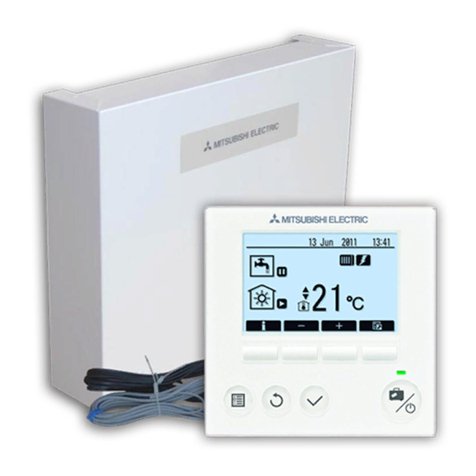
Mitsubishi Electric
Mitsubishi Electric PAC-IF071B-E installation manual
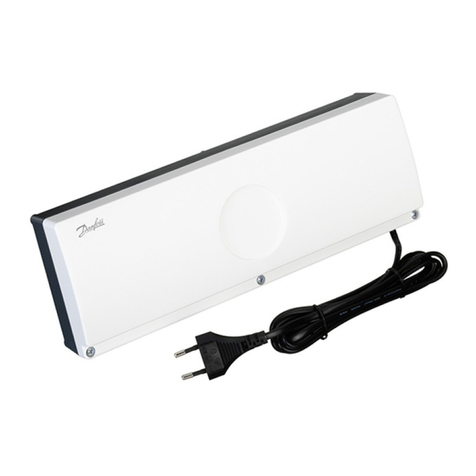
Danfoss
Danfoss FH-WC installation guide
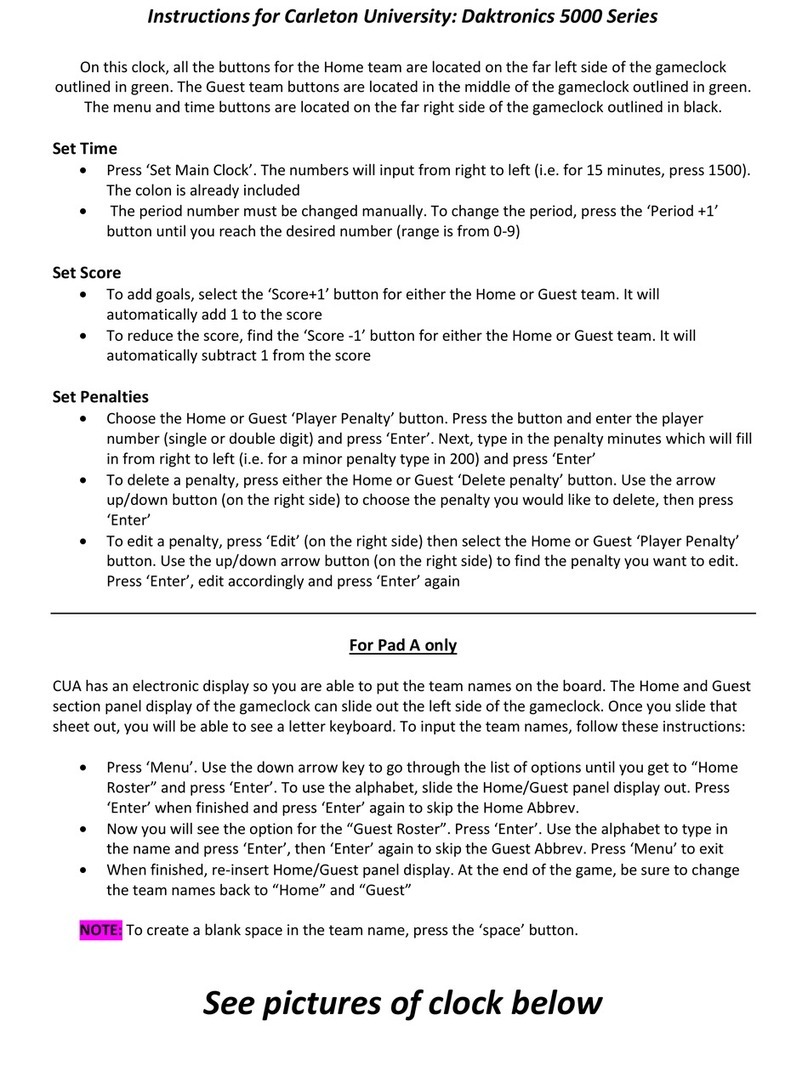
Daktronics
Daktronics 5000 Series instructions
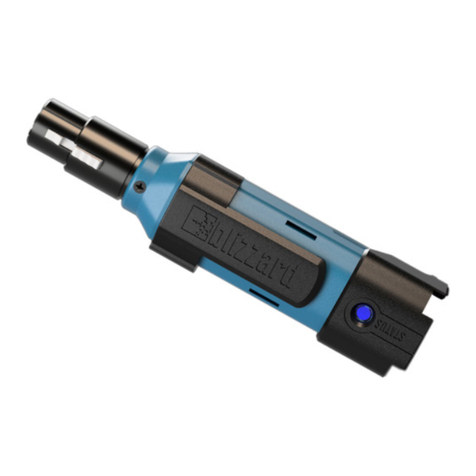
Blizzard Lighting
Blizzard Lighting SoC-It quick start guide
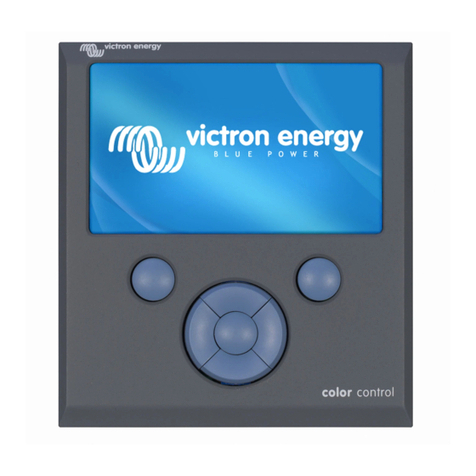
Victron energy
Victron energy Color Control GX Faq

ETC
ETC F-Drive W1 Series installation manual
